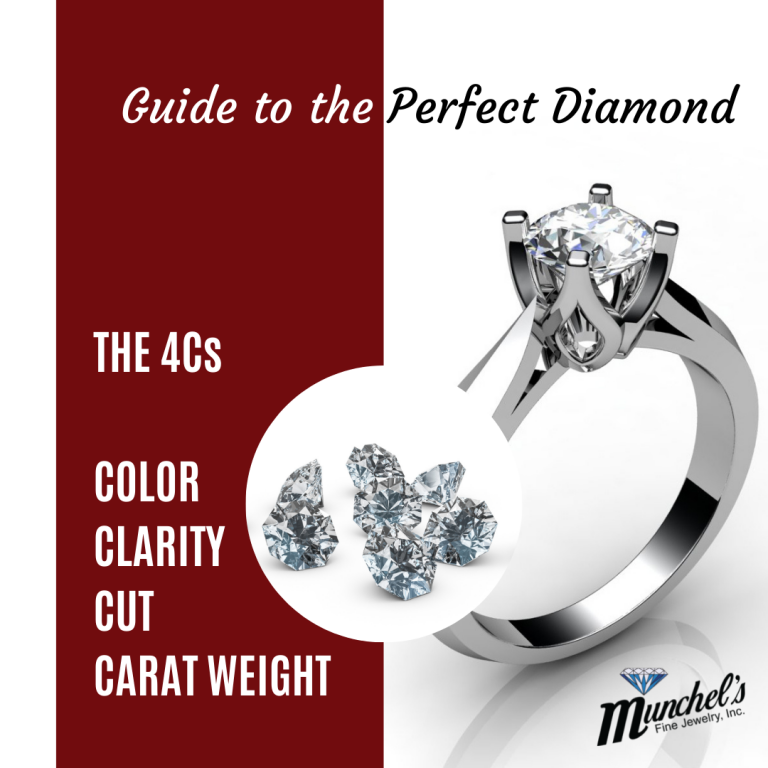Your Guide to Choosing the Perfect Diamond
Feel confident of your next diamond purchase by learning more about the 4C’s and what they mean.

Undoubtedly, diamonds are beautiful and timeless; and are likely treasured by all who own them. At first glance, it may be difficult to discern the true value of a diamond. Unless you’re an expert gemologist or you’ve acquired a vast knowledge of the 4C’s, you may have found or will find yourself in a predicament of overpaying and compromising on quality for a diamond purchase. Never guess again – learn more about the four factors that distinguish the most important parts of a diamond.
The 4 Cs
The 4Cs were originally developed in the 1940s by Gemological Institute of America (GIA) founder Robert M. Shipley as a mnemonic device to help his students. Since then, the 4Cs have revolutionized the diamond industry, and through continuous research and education, jewelers have been able to decode the best practice of determining a diamond’s quality.
Color
A diamond should have “an absence of color” to be considered chemically pure and structurally perfect, according to the GIA. The degrees of colorlessness of a diamond range from D (the highest value and the clearest) and fluctuate down to a Z (the lowest value and can look light yellow or brown). The slightest color imperfections can make the biggest differences in price and value. Because of this, it’s important to have an expert gemologist look at the diamond to verify the correct color grade range you are looking for.
Clarity
Clarity stands for the quality of transparency or purity. When a diamond has internal inclusions or external blemishes, it rates lower on the GIA Diamond Clarity Scale. This scale has six categories and a total of 11 specific grades:
- Flawless (FL) – There are no inclusions or blemishes visible under 10 times magnification.
- Internally Flawless (IF) – There are no inclusions visible under 10 times magnification.
- Very, Very Slightly Included (VVS1 and VVS2) – Inclusions are so slight, they are difficult for a skilled grader to see under 10 times magnification.
- Very Slightly Included (VS1 and VS2) – Inclusions are observed with effort under 10 times magnification but can be characterized as minor.
- Slightly Included (SI1 and SI2) – Inclusions are noticeable under 10 times magnification.
- Included (I1, I2, and I3) – Inclusions are evident under 10 times magnification and may affect transparency and brilliance.
These guidelines help jewelers and gemologists assess the diamond for customers so they can make an informed decision on which diamond is the best choice for their budget and desired look.
Cut
A diamond’s cut quality is often what makes it the most attractive. The cut of a diamond refers to how symmetrical the stone is, along with its weight, diameter, durability, brilliance, and luminosity. A poorly cut diamond will often appear dull, while a well-cut diamond will easily reflect colored light. The cut of a diamond does not refer to the actual shape such as a round brilliant, princess, oval, or pear. However, the round brilliant diamond is one of the most popular diamond shapes due to its maximum sparkle and contrast.
To determine a diamond’s cut grade, a gemologist will review the diamond under magnification and compare it to the GIA’s Diamond Cut Scale. This scale includes fire (the distribution of white light into all the colors of the rainbow), brightness (the white light reflected from the diamond), and scintillation (the amount of sparkle a diamond produces when light moves). Upon appraisal, the gemologist will then determine if the diamond is excellent or poor, or anything in between.
Carat Weight
A carat is the unit of weight used to measure the size of a gemstone, including a diamond. To approximate the carat weight of a diamond, your jeweler will need to have a scale that measures stones precisely. You may think you want a stone with a high carat weight because it means the diamond is more valuable – however, this is not always the case. For example, a one-carat diamond may be worth more than a three-carat diamond due to factors such as its superior cut, clarity, and color. It’s best to choose a diamond not solely based on its weight.
The End Result
It’s important to determine a diamond’s value using all four of the 4Cs instead of merely one or two independently. You may love the cut and carat weight of a diamond, but if the clarity and color are mediocre, you may end up regretting your purchase in the long run.
When it comes to selecting the perfect diamond for your price range and style preferences, Munchel’s Fine Jewelry can help ensure you make the best decision by utilizing the 4Cs.
About Munchel’s Fine Jewelry
Munchel’s Fine Jewelry Inc. is a family owned and operated business. We have been proudly serving Central Florida with quality jewelry and services for over 30 years. Our commitment and dedication to our customers is what sets us apart. We offer a large selection of jewelry and collectible items, including coins, watches, lockets, and necklaces. In addition, we also buy, sell, and trade many types of timeless pieces. For more information, please contact us at (863) 619-6269 or visit our website at Munchels.com/.


